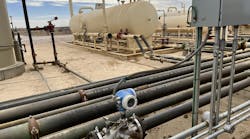Ultrasonic flowmeters have gained a much wider acceptance over the last decade as end users come to understand the value of this technology. In fact, ultrasonic flow metering is currently one of the fastest-growing flow metering technologies. Although this technology's acceptance and growth have only happened more recently, ultrasonic flowmeters have been commercially available for several decades. Some of the earliest prototypes date back to the 1960s.
This abrupt rise in popularity can be attributed to several underlying causes. Advancements in signal processing have led to improved noise filtering and ultimately increased flow metering accuracy. Users have moved away from older mechanical-type flow metering technologies as mechanical meters require periodic maintenance, and failure rates can be high. Vendors have also developed products catered to specific industries and applications, including the ability to measure not only liquids but also gases and steam. This targeted product development has helped to grow the technology's use across multiple industries and sectors.
What is clamp-on ultrasonic flow metering?
To understand clamp-on ultrasonic flow metering, let us start with the basics of all ultrasonic flow metering. The term "ultrasonic" describes the soundwave frequency used in these flowmeters. Sound waves above 20 kHz are at "ultrasonic" frequencies and cannot be heard by humans. Ultrasonic flowmeters use these sound waves to measure flow rate. The meter's transducers generate these frequencies by utilizing a piezoelectric crystal to convert an electrical signal into a sound wave signal.
The type of ultrasonic flowmeter used determines how these sound wave signals are transmitted, received and processed to determine a flow rate measurement. There are two broad types of ultrasonic flowmeters: inline and clamp-on.
Inline meters utilize transducers that are in contact with the process fluid. Typically, the transducers are mounted on a pre-built spool piece of a standard length. These pre-built spool pieces ensure the transducers are at the proper angle for operation and make the installation easy for the user. Inline meters have a longer history of use and tend to be more accurate. This accuracy advantage is due to the signal degradation caused by the pipe wall, pipe scaling, and installation inconsistencies of clamp-on style meters. Typically, inline meters are preferred for use in custody transfer applications. Custody transfer or fiscal metering refers to flow metering applications where the fluid being metered changes ownership between parties. These applications represent a tiny fraction of all applications that are suitable for ultrasonic flow metering.
As the name implies, clamp-on meters mount to the outside of the pipe and do not directly contact the process fluid. Clamp-on style meters are undergoing significant technology improvements, are the faster growing of the two types, and offer unique benefits.
Types of clamp-on ultrasonic flow metering
All ultrasonic flowmeters operate using sound wave signals, but they do not all operate in the same way. There are two types of clamp-on ultrasonic flowmeters: transit-time and doppler. They differ in how they transmit, receive and process these sound wave signals.
Transit-time meters use a pair of transducers. Both transducers act as transmitters and receivers of these sound wave signals. Sound waves moving in a fluid carry faster when traveling in the fluid flow direction (downstream) and slower when traveling against the fluid flow (upstream). If there were no fluid flow, the times would be identical. This time difference is measured, and from that, a fluid velocity is calculated. With the area of the pipe and fluid velocity known, the meter calculates a volumetric flow rate. If the fluid density is also known, a mass flow rate can be calculated as well.
Transit-time meters are the more versatile of the two types. They are capable of metering liquids, gases and steam. However, typically a single meter will only work with one of these fluid types. Transit-time liquid meters require that the liquid have minimal amounts of particulate solids or entrained bubbles as they can interfere with the sound wave signal.
Doppler flowmeters also use ultrasonic sound waves sent through the pipe and into the fluid. But instead of measuring a time differential, a doppler meter measures the frequency shift of the sound wave signal. This frequency shift is proportional to the fluid's velocity. This phenomenon is the well-known and understood doppler effect.
Doppler meters rely on their sound wave signals being deflected back by particulate solids or air bubbles in the flow stream. These particles travel at the same speed as the fluid, so they act as an accurate reference. For this reason, doppler meters are limited to metering liquids only and specifically liquids with particulate solids or entrained bubbles. Due to these limitations, doppler meters are typically used on dirty or aerated liquids and slurries.
Transit-time and doppler flowmeters are complementary. Liquid applications with particulate solids or bubbles are unsuitable for transit-time metering but ideal for doppler metering. Clean liquids, gases or steam applications are unsuitable for doppler metering but ideal for transit-time metering.
Thermal energy metering
Thermal energy meters, or BTU meters, measure the energy of hydronic-based heating and cooling systems. Thermal energy meters consist of a volumetric flow sensor, temperature sensors and a flow computer. Volumetric flow rate and temperature measurements feed into the flow computer, where the necessary calculations are performed to produce a thermal energy measurement.
Metering thermal energy in this fashion continues to grow in importance, with environmental regulations and financial incentives being the primary drivers. District energy systems and commercial facilities such as universities, hospitals and airports are adopting thermal energy metering to optimize the performance of their HVAC systems. These modern systems are complex, consisting of chilled and hot water systems, boilers, cooling towers, pumps and metering equipment. Optimizing these systems is well worth the investment. Increasing energy efficiencies of the heating and cooling infrastructure leads to more environmentally friendly facilities and significant cost savings.
Older facilities typically do not have thermal energy metering capabilities. These requirements have come about more recently through increased environmental regulations and initiatives. Clamp-on ultrasonic thermal energy meters are ideal for retrofitting these older systems, as costly and time-consuming piping modifications are not required.
Portable flow metering
Up to this point, the discussion has been surrounding fixed-mount clamp-on flowmeters. Fixed-mount meters reside in one location, with the electronics enclosure typically mounted to a wall or pipe. The clamp-on transducers, however, can easily be installed, removed and mounted to another site. As a result of the clamp-on transducer design, this flow metering technology is uniquely suited for a portable flowmeter design. Pairing the clamp-on transducer design with handheld electronics yields the portable ultrasonic flowmeter. These portable meters typically include handheld electronics, transducers, transducer fixtures, and all the needed accessories in a compact carrying case.
This portability lends itself to unique uses that fixed-mount flowmeters are incapable of performing. These uses include spot checking, verifying the accuracy of another flowmeter, and being used as a placeholder for fixed-mount meters.
Spot checking refers to taking a flow rate measurement where there is no fixed-mount meter, but the measurement is only required temporarily. Spot checking is commonly performed during a flow rate survey of an entire system. These surveys involve taking measurements in multiple locations throughout the piping system. Surveys help users better understand flow rates throughout the system, determine baseline flow rates, and detect leaks and blockages.
Another common use for portable meters is to verify the accuracy of another meter. If a meter displays an erratic or unusual measurement, it could be cause for alarm. Using a portable flowmeter to verify the meter's reading can help determine whether there is an issue with the process or the meter.
Many process facilities have periodic calibration requirements for their instrumentation. These calibrations often involve removing a flowmeter from the process to have the calibration performed at an accredited calibration facility. Unfortunately, this can leave process operators without a critical process measurement. A portable flowmeter can be used as a temporary placeholder until the fixed-mount meter can be reinstalled. Many portable flowmeter vendors offer a variety of signal output options, such as an analog output, so that these portable meters can tie into the control system seamlessly.
Many process operators utilize a combination of fixed mount and portable ultrasonic clamp-on flowmeters to maximize their process visibility while keeping equipment costs down. A successful strategy that many employ is to use fixed mount installations for critical measurements and portable meters for temporary measurements to cover potential blind spots. Many vendors also offer rental programs — should a temporary need arise.
Advantages and disadvantages of clamp-on ultrasonic flow metering
Ultimately, the intended application will significantly influence whether clamp-on ultrasonic technology is suitable. But like any flow metering technology, clamp-on ultrasonic flowmeters have inherent advantages and disadvantages.
Key advantages of clamp-on ultrasonic flow metering include:
- Non-invasive installation, no piping modifications required.
- No moving parts, no maintenance required.
- No wetted parts, no issues with chemical compatibility.
- No measurement drifting, no recalibration required.
- No pressure drop.
- Relatively high turndown ratio.
- Ability to measure liquids, gases, and steam (transit-time models).
- Provides both downstream and upstream flow measurements (bi-directional).
- Easy to install, remove and transport to different locations (portable models).
- A single meter can be used with a wide variety of pipe sizes, pipe materials and process fluids.
- Thermal energy models provide an energy (BTU) measurement.
Key disadvantages of clamp-on ultrasonic flow metering include:
- Pipe scaling, pitting and fouling can negatively affect measurement accuracy.
- Not as accurate as inline ultrasonic flowmeters and some other flow metering technologies.
- Not suitable for use on liquids with particulate solids or entrained air (transit-time models).
- Only suitable for use on liquids with particulate solids or entrained air (doppler models).
- Pipes with external coatings or internal liners can be problematic.
- Pipe must be full of fluid for proper operation.
- Requires unobstructed upstream and downstream straight piping lengths for proper operation.
Conclusion
Clamp-on ultrasonic flow metering will continue to grow in use as the benefits outweigh the drawbacks for an increasing number of flow metering applications. Although currently predominate in specific industries, the technology will continue to spread to other industries as vendors continue to develop products catering to them. Many users will be introduced to the technology using portable models as there are currently no other commercially viable portable flow metering products. As with selecting any type of process instrumentation, the specific application requirements will determine which technology is most suitable.






